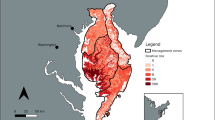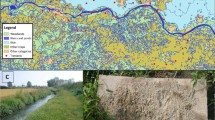Abstract
Nutria (Myocaster coypus), invasive, semi-aquatic rodents native to South America, were introduced into Maryland near Blackwater National Wildlife Refuge (BNWR) in 1943. Irruptive population growth, expansion, and destructive feeding habits resulted in the destruction of thousands of acres of emergent marshes at and surrounding BNWR. In 2002, a partnership of federal, state and private entities initiated an eradication campaign to protect remaining wetlands from further damage and facilitate the restoration of coastal wetlands throughout the Chesapeake Bay region. Program staff removed nearly 14,000 nutria from five infested watersheds in a systematic trapping and hunting program between 2002 and 2014. As part of ongoing surveillance activities, the Chesapeake Bay Nutria Eradication Project uses a variety of tools to detect and remove nutria. Project staff developed a floating raft, or monitoring platform, to determine site occupancy. These platforms are placed along waterways and checked periodically for evidence of nutria visitation. We evaluated the effectiveness of monitoring platforms and three associated detection methods: hair snares, presence of scat, and trail cameras. Our objectives were to (1) determine if platform placement on land or water influenced nutria visitation rates, (2) determine if the presence of hair snares influenced visitation rates, and (3) determine method-specific detection probabilities. Our analyses indicated that platforms placed on land were 1.5–3.0 times more likely to be visited than those placed in water and that platforms without snares were an estimated 1.7–3.7 times more likely to be visited than those with snares. Although the presence of snares appears to have discouraged visitation, seasonal variation may confound interpretation of these results. Scat was the least effective method of determining nutria visitation, while hair snares were as effective as cameras. Estimated detection probabilities provided by occupancy modeling were 0.73 for hair snares, 0.71 for cameras and 0.40 for scat. We recommend the use of hair snares on monitoring platforms as they are the most cost-effective and reliable detection method available at this time. Future research should focus on determining the cause for the observed decrease in nutria visits after snares were applied.


Similar content being viewed by others
References
Akaike H (1973) Information theory and an extension of the maximum likelihood principle. In: Petrov DN, Cazakil F (eds) 2nd international symposium information theory, Akademia Kidao, Budapest, Hungary, pp 267–281
Baker SJ, Clarke CN (1988) Cage trapping Coypus (Mycastor coypus) on baited rafts. J Appl Ecol 25:41–48
Bryce R, Oliver MK, Davies L, Gray H, Urquhart J, Lambin X (2011) Turning back the tide of American mink invasion at an unprecedented scale through community participation and adaptive management. Biol Conserv 144:575–583
Burnham KP, Anderson DR (2002) Model selection and multimodel inference: a practical information-theoretic approach, 2nd edn. Springer, New York
Clavero M, Garcia-Berthou E (2005) Invasive species are a leading cause of animal extinctions. Trends Ecol Evol 20:110
Evans J (1970) About nutria and their control. Resource Publication No. 86, Bureau of Sport Fisheries and Wildlife, Denver
Foote AL, Johnson LA (1993) Plant stand development in Louisiana coastal wetlands: nutria grazing effects on plant biomass. In: Laridin MC (ed) Wetlands: proceedings of the 13th annual conference of the Society of Wetland Scientists. South Central Chapter, Society of Wetland Scientists, Utica, MS, USA, pp 265–269
Haramis GM, Colona R (1999) The effect of nutria (Myocastor coypus) on marsh loss in the lower eastern shore of Maryland: An enclosure study. United States Geological Survey. http://www.pwrc.usgs.gov/resshow/nutria.htm. Accessed Sep 2014
Harris VT, Webert F (1962) Nutria feeding activity and its effect on marsh vegetation in southwestern Louisiana. Special Scientific Report Wildlife No. 64, US Fish and Wildlife Service, Washington, DC
Hines JE (2006) PRESENCE—software to estimate patch occupancy and related parameters. USGS-PWRC. http://www.mbr-pwrc.usgs.gov/software/presence.html
Kerr K, Dawson D (2013) A new twist on an old device: innovative hair snare helps monitor nutria. Wildl Prof 7:35–37
Linscombe G, Kinler N (1997) A survey of vegetative damage caused by nutria herbivory in the Barataria and Terrebonne basins. Barataria-Terrebonne National Estuary Program Publication No. 31, Thibodaux, LA, USA
MacKenzie DI, Nichols JD, Royle JA, Pollock KH, Bailey LA, Hines JE (2006) Occupancy modeling and estimation. Academic Press, San Diego, CA, 324 pp
Newey S, Davidson P, Nazir S, Fairhurst G, Verdicchio F, Irvine RJ, van der Wal R (2015) Limitations of recreational camera traps for wildlife management and conservation research: a practitioner’s perspective. Ambio 44(Suppl. 4):624–635. doi:10.1007/s13280-015-0713-1
Nichols JD, Bailey LL, O’Connell AF Jr, Talancy NW, Campbell EH, Grant EHC, Gilbert AT, Annand EM, Husband TP, Hines JE (2008) Multi-scale occupancy estimation and modeling using multiple detection methods. J Appl Ecol 45:1321–1329
Pimentel D, Zuniga R, Morrison D (2005) Update on the environmental and economic costs associated with alien-invasive species in the United States. Ecol Econ 52(3):273–288
R Development Core Team (2013) R: a language and environment for statistical computing. R Foundation for Statistical Computing, Vienna
Reynolds JC, Short MJ, Leigh RJ (2004) Development of population control strategies for mink Mustela vison, using floating rafts as monitors and trap sites. Biol Conserv 120:533–543
Willner GR, Chapman JA, Pursley D (1979) Reproduction, physiological responses, food habits, and abundance of nutria on Maryland marshes. Wildl Monogr 65:3–43
Witmer GW, Burke PW, Jojola S, Nolte DL (2008) A live trap model and field trial of nutria (Rodentia) multiple capture trap. Mammalia 72:352–354
Acknowledgements
We greatly appreciate the help and support from our colleagues at the Chesapeake Bay Nutria Eradication Project. We thank the Nutria Management team, Blackwater National Wildlife Refuge and in particular Kevin Sullivan, Steven Schwartz, Bryson Webber, William Wilmoth and Robert Colona for their help and guidance with this research.
Author information
Authors and Affiliations
Corresponding author
Rights and permissions
About this article
Cite this article
Pepper, M.A., Herrmann, V., Hines, J.E. et al. Evaluation of nutria (Myocastor coypus) detection methods in Maryland, USA. Biol Invasions 19, 831–841 (2017). https://doi.org/10.1007/s10530-016-1312-1
Received:
Accepted:
Published:
Issue Date:
DOI: https://doi.org/10.1007/s10530-016-1312-1




